
For over four years, it has been a binding requirement on public sector employers with over 250 employees (as at their snapshot date) to report on their gender pay gap, as we have previously reported. Due to the disruption of the pandemic, enforcement of the 2019/20 reporting requirement was suspended indefinitely and the 2020/21 reporting deadline was delayed from 30 March 2021 to 5 October 2021. However, we now appear to be back to ‘business as usual’ where gender pay reporting requirements are concerned – and public sector employers that had over 250 employees on 31 March 2021 must report their gender pay gaps by 30 March 2022.
Gender Pay Gap Reporting requirements
It is important to note that gender pay gap reporting must occur on a per legal entity basis. So, in the context of a multi-academy trust spread across multiple sites, the gender pay gap report must encompass the data for the entire Trust. The significance of the snapshot date to the reporting exercise, meanwhile, cannot be underestimated. When constructing the report, you must identify the pay period that encompassed the snapshot date of 31 March and then consider the ‘ordinary pay’ received, and hours worked, by full-pay relevant employees within that period. You must also consider any bonuses paid in the 12 months leading up to the snapshot date.
Utilising this data, you must calculate the following:
- The mean hourly rate gap between males and female employees that were full-pay relevant in the snapshot period.
- The median hourly rate gap between males and female employees that were full-pay relevant in the snapshot period.
- The mean bonus pay gap between male and female employees of the organisation on the snapshot date.
- The median bonus pay gap between male and female employees of the organisation on the snapshot date.
- The pay quartile percentage breakdowns by gender, looking at employees that were full-pay relevant in the snapshot period.
The process through which these calculations are produced is complex, due to the intricacy of the regulations governing the area. These regulations are very specific, in how they define concepts such as ‘ordinary pay’ and ‘full-pay relevant employees’.
Supporting our clients with Gender Pay Gap Reporting services
At Dataplan, we offer a specialist gender pay gap reporting service, which applies the legislation in a fully compliant manner. We are adept at taking into account multiple job roles and calculating consolidated hourly rates for employees with more than one contract.
On top of this, we are able to produce branded, customised infographics for clients – ready for publication on organisations’ websites. This runs alongside further, intensive support that we offer – helping employers to ‘drill down’ and understand their gender pay gap by factors such as age, FT/PT status and seniority of role. We can also assist employers in contextualising their gender pay gaps and producing coherent written statements that explain their figures.
For further advice on how Dataplan can support your organisation with gender pay gap reporting please contact us.
